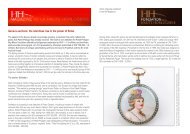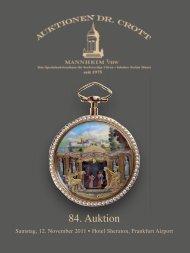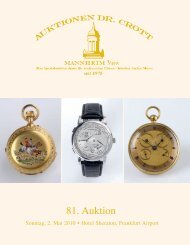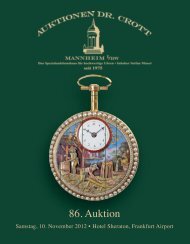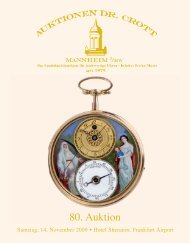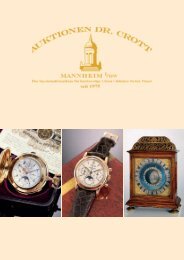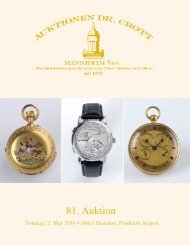- Seite 1 und 2:
83. Auktion Sonntag, 8. Mai 2011
- Seite 3 und 4:
Unser Team / Our Team Susanne Bruck
- Seite 5 und 6:
Hinweise zur Auktion Saalbieter Wen
- Seite 7 und 8:
Internationale Repräsentanten Inte
- Seite 9 und 10:
1 J. Assmann, Glashütte i/Sachsen,
- Seite 11 und 12:
3 A. Lange & Söhne Glashütte i/SA
- Seite 13 und 14:
7 Deutsche Uhrmacherschule Glashüt
- Seite 15 und 16:
9 A. Lange & Söhne Glashütte bei
- Seite 17 und 18:
11* A. Lange & Söhne Glashütte B/
- Seite 19 und 20:
15 Lange & Gutkaes, Dresden / Sir J
- Seite 21:
19 A. Lange & Söhne Glashütte B/D
- Seite 24 und 25:
21 A. Lange & Söhne Glashütte i/S
- Seite 26 und 27:
25 24 24 A. Lange & Söhne Glashüt
- Seite 28 und 29:
29 A. Lange & Söhne Glashütte B/D
- Seite 30 und 31:
33 A. Lange & Söhne Glashütte i/S
- Seite 32 und 33:
38 37 37 A. Lange & Söhne Glashüt
- Seite 35 und 36:
40 Cartier à Paris, Cartier Nr.
- Seite 37 und 38:
43 Patek Philippe à Genève, Werk
- Seite 39 und 40:
50* Unsigniert, Frankreich, Werk Nr
- Seite 41 und 42:
54* J. E. Caldwell & Co., Philadelp
- Seite 43 und 44:
58* Drocourt / Goldsmiths’ Allian
- Seite 45 und 46:
61 Fatio Junod à Genève, Höhe 21
- Seite 47:
64 Regnault à Paris, Werk Nr. 2393
- Seite 50 und 51:
69 70 71 (1733-1813) und Gédéon-F
- Seite 52 und 53:
73 Peacock, London, Werk Nr. 2192,
- Seite 54 und 55:
76 Edelynne à Paris, Werk Nr. 325,
- Seite 56 und 57:
80* David Trembley à Paris, Werk N
- Seite 58 und 59:
83 84 82
- Seite 60 und 61:
A decorative, heavy verge pocket wa
- Seite 62 und 63:
89* John Moncreif, London, Werk Nr.
- Seite 64 und 65:
92 William Rivers, London, Werk Nr.
- Seite 66 und 67:
96 97 98 96 Samson, Werk Nr. 500, 5
- Seite 69 und 70:
100 101 100 J. B. Baillon à Paris,
- Seite 71 und 72:
104 Coste & Henry, Lausanne, 33 mm,
- Seite 73 und 74:
107 Willem Jan Bramer, Amsterdam, 4
- Seite 75 und 76:
111 Unsigniert, Frankreich, 41 mm,
- Seite 77 und 78:
115 Georg Christoph Eppen à Dresde
- Seite 79:
119 Julien Le Roy à Paris, Werk Nr
- Seite 82 und 83:
122 123 124 122 William Gordon, Dub
- Seite 84 und 85:
127 Vermutlich süddeutsche Renaiss
- Seite 86 und 87:
129 Türmchenuhr - vermutlich südd
- Seite 88 und 89:
An one-handed turret clock with hou
- Seite 90 und 91:
134 Christoph Schöner, Augsburg, 9
- Seite 93 und 94:
136 Conradt Schäffer, Budissin, 10
- Seite 95:
138 Süddeutsche Renaissance Türmc
- Seite 99:
140 Punzierung “FG” und Stadtma
- Seite 102 und 103:
142 Unsigniert, 110 mm, 819 gr., ci
- Seite 104 und 105:
http://en.wikipedia.org/wiki/File:F
- Seite 106 und 107:
145 Carl Wichmann, Wien, 155 x 140
- Seite 108 und 109:
147 Französisches Renaissance Tisc
- Seite 111:
149 Michel Schultz à Dantzig, 95 x
- Seite 115:
151 Elias Kreittmayer, Friedberg, 1
- Seite 118 und 119:
http://www.romeartlover.it/Vasi19.h
- Seite 121:
154 Meisterpunze “MW” und Stadt
- Seite 124 und 125:
158 International Watch Co., Werk N
- Seite 126 und 127:
The “50th Anniversary Watch” In
- Seite 128 und 129:
165 166 167* 165 Patek Philippe & C
- Seite 130 und 131:
170* E. Gübelin, Lucerne Swiss, We
- Seite 132 und 133:
174 Chronometre Election, Swiss, Ge
- Seite 134 und 135:
177 Patek Philippe à Genève, Werk
- Seite 136 und 137:
180 Patek Philippe & Co. Geneva, /
- Seite 139 und 140:
Case: nickel-plated, steel push bac
- Seite 141 und 142:
187 A. Lange & Söhne, Glashütte i
- Seite 143 und 144:
191 Omega, Swiss, Werk Nr. 7066018,
- Seite 145 und 146:
196 International Watch Co., Schaff
- Seite 147 und 148:
198 International Watch Co., Schaff
- Seite 149 und 150:
200 International Watch Co., Schaff
- Seite 151 und 152:
202 International Watch Co. Schaffh
- Seite 153 und 154:
206 International Watch Co. Schaffh
- Seite 155 und 156:
209 International Watch Co., Schaff
- Seite 157:
212 Swiza / Rolls Royce, Geh. Nr. 1
- Seite 160 und 161:
216 Audemars Piguet Genève, Werk N
- Seite 162 und 163:
220 International Watch Co., Schaff
- Seite 164 und 165:
223 International Watch Co., Schaff
- Seite 166 und 167:
226 Dubois Frères, Werk Nr. 22564,
- Seite 168 und 169:
229* Signatur Breguet à Paris, Geh
- Seite 170 und 171:
232 Lapierre in Wien, 57 mm, 70 gr.
- Seite 172 und 173:
235 Unsigniert, Schweiz, Geh. Nr. 1
- Seite 174 und 175:
239 Piguet & Meylan à Brassus, No.
- Seite 177:
241 Edward Prior, London, Werk Nr.
- Seite 181 und 182:
243 Hochfeine, schweizer Goldemail-
- Seite 183 und 184:
245* Gray & Constable, London, Werk
- Seite 185:
247 Punzierung “E.T.”, Genf, 72
- Seite 189:
249 Außerordentlich seltene, klein
- Seite 192 und 193:
251* Unsigniert, Frankreich, Werk N
- Seite 194 und 195:
253 Punzierung “G&C”, Schweiz,
- Seite 196 und 197:
255* Philippe Terrot à Genève, We
- Seite 199 und 200:
257 Punziert, Österreich, Höhe 19
- Seite 201:
259 Punzierung unleserlich, vermutl
- Seite 205 und 206: 261 Matthey & Comp., Werk Nr. 672,
- Seite 207 und 208: 265* Unsigniert, Frankreich, Geh. N
- Seite 209: 267* “S&C” (Souchay & Colin), 9
- Seite 212 und 213: 269 Le Bon à Paris, Werk Nr. 721,
- Seite 214 und 215: 273 Unsigniert, Schweiz, Höhe 41 m
- Seite 217 und 218: 276 Unsigniert, Schweiz, Höhe 34 m
- Seite 219 und 220: 280 Charles Bruguier à Genève, We
- Seite 221: 281* J. Paulet, London, Werk Nr. 39
- Seite 225 und 226: 283 Monogrammist “TF” (verm. Fe
- Seite 227 und 228: 285* Meistermarke “GT”, Neuchâ
- Seite 229: 287 Hochfeines, sehr seltenes, Wien
- Seite 233 und 234: 289 “Brevet S.G.D.G”, Schweiz,
- Seite 235: 293 Punze “M&J” unter Krone, Ge
- Seite 238 und 239: 295* L. Duchêne & fils à Genève,
- Seite 241: 297* Feine, Schweizer Goldemail-Sch
- Seite 245 und 246: Eine weitere “Blois” Uhr mit na
- Seite 247: 300 Felix Borle, 49 mm, 105 gr., ci
- Seite 250 und 251: 302 Unsigniert, Geh. Nr. 47556, 24
- Seite 252 und 253: 304 Unsigniert, Schweiz, 53 mm, 106
- Seite 255: 306 Museale Goldemail-Präsentdose
- Seite 259: 308* “HN” (Henri Neisser), Gen
- Seite 263: 310 John Ellicott, London, 57 mm, 1
- Seite 266 und 267: Moss Agate Dendritic agate, more co
- Seite 269: 313 Charles Bruguier à Genève, We
- Seite 273 und 274: 314 Eisenuhr mit Stundenschlag, Hö
- Seite 275 und 276: 317 Estienne Asselin London Fecit,
- Seite 277 und 278: 319* Joseph Norris Amsterdam, Höhe
- Seite 279 und 280: 321 John Taylor, London, Höhe 610
- Seite 281 und 282: 323 Extrem seltene “Pendule Indus
- Seite 283: 325 Seltene Pariser Prunk-Pendule m
- Seite 287: 327 Lepaute, Horologer de l’Emper
- Seite 291: 329 Grandchamps Fils à Paris, Höh
- Seite 295 und 296: 331* Janvier au Louvre, Paris, Nr.
- Seite 297: 332 “Fecit Frus Salneuve” / Jea
- Seite 301: 334 Antonius Melchionna Fecit Romae
- Seite 305: 336 Außergewöhnliche, äußerst r
- Seite 309:
emalte Kupferpaneel der vorliegende
- Seite 313:
is decorated with a painted copper
- Seite 316 und 317:
339 Unsigniert, DRP Nr. 100870 / 22
- Seite 318 und 319:
342 Riefler, Nesselwang, circa 1920
- Seite 320 und 321:
344 Strasser & Rohde, Glashütte in
- Seite 322 und 323:
Elektrische Nebenuhr Dr. S. Riefler
- Seite 325:
347 Solvil/Paul Ditisheim Genève,
- Seite 329 und 330:
349 Ulysse Nardin, Le Locle / Augus
- Seite 331 und 332:
353 Chronometre, Ulysse Nardin, Loc
- Seite 333 und 334:
357 International Watch Co., Werk N
- Seite 335 und 336:
359 Longines Watch Co., Werk Nr. 96
- Seite 337 und 338:
362 Meister Zürich by Thomas Merce
- Seite 339 und 340:
366 Kirowa/1. Moskauer Uhrenfabrik,
- Seite 341:
368 Breguet et fils, Werk Nr. 4591,
- Seite 344 und 345:
Edward Thomas Loseby (1817-1890) An
- Seite 346 und 347:
372 Rolex “Cellini”, Geh. Nr. 6
- Seite 348 und 349:
376 Rolex “Oyster Perpetual Day-D
- Seite 350 und 351:
379 Rolex “Officially Certified C
- Seite 352 und 353:
383 Rolex “Oyster Perpetual Date
- Seite 355 und 356:
386 Rolex “Oyster Perpetual GMT-M
- Seite 357 und 358:
388 389 388 Rolex “Oyster Perpetu
- Seite 359 und 360:
391 Rolex “Chronograph”, Geh. N
- Seite 361:
393 Rolex “Oyster Perpetual offic
- Seite 364 und 365:
397 Patek Philippe à Genève, “E
- Seite 366 und 367:
401 Patek Philippe à Genève, “E
- Seite 368 und 369:
405 Patek Philippe à Genève, “C
- Seite 370 und 371:
409 Patek Philippe Genève, Werk Nr
- Seite 372 und 373:
411 Patek Philippe & Co. à Genève
- Seite 374 und 375:
414 Patek Philippe à Genève, “T
- Seite 377 und 378:
416 Perrelet 1777, Swiss, “Automa
- Seite 379 und 380:
419 Vacheron & Constantin à Genèv
- Seite 381 und 382:
423 Omega “Anti-Magnétique”, W
- Seite 383 und 384:
425 Omega “Chronometer Automatic
- Seite 385 und 386:
429 Omega “Seamaster Professional
- Seite 387 und 388:
432 International Watch Co., Schaff
- Seite 389 und 390:
435 Longines, Werk Nr. 5463841, Geh
- Seite 391 und 392:
439 Omega “Seamaster XVI”, Werk
- Seite 393 und 394:
442 Heuer “Calculator”, Automat
- Seite 395 und 396:
447 Breitling à Genève, “Chrono
- Seite 397 und 398:
451 Corum “Platinum Bar”, Werk
- Seite 399 und 400:
459 Omega “Automatic Chronometer
- Seite 401 und 402:
463 Jaeger Le Coultre “Memovox”
- Seite 403 und 404:
467 Franck Muller à Genève “Tou
- Seite 405 und 406:
469 Audemars Piguet Genève “Jule
- Seite 407:
471 A. Lange & Söhne, Glashütte i
- Seite 410 und 411:
473 Ris à Berne, 57 mm, 192 gr., c
- Seite 413:
475 Gerard Mut, Francefort, 65 mm,
- Seite 416 und 417:
477 Viotte, 56 mm, 53 gr., circa 18
- Seite 419 und 420:
479 Breguet et fils “Horloger de
- Seite 421 und 422:
480 “MG”, Geh. Nr. 5851, 55 mm,
- Seite 423 und 424:
482* August Lentz, 48 mm, 83 gr., c
- Seite 425:
484* Johannes Ruegger à Genève, W
- Seite 428 und 429:
487 Fattorini & Sons, Bradford / Wa
- Seite 430 und 431:
http://watch-wiki.org/index.php?tit
- Seite 433:
www.luisa-haeuser-frauenstiftung.de
- Seite 437 und 438:
492 Le Coultre & Cie., Le Sentier,
- Seite 439 und 440:
497 Invar, Médaille d’Or Milan 1
- Seite 441:
499 Paul Ditisheim, Swiss, Grand Pr
- Seite 444 und 445:
The Army & Navy Cooperative Society
- Seite 446 und 447:
504 Courvoisier & Comp., La Chaux-d
- Seite 448 und 449:
509 510 511* 509 Chevalier & Cochet
- Seite 450 und 451:
514 Fredrik Jürgensen, Kiöbenhavn
- Seite 452 und 453:
519 518 Johannes Ruegger à Genève
- Seite 454 und 455:
521 Dubois & fils, Le Locle, Geh. N
- Seite 456 und 457:
525 526 527 525* Jules Jürgensen,
- Seite 458 und 459:
530 Jules Jürgensen, Copenhagen, W
- Seite 460 und 461:
534 Jules Jürgensen, Copenhagen, W
- Seite 462 und 463:
537 Jules Jürgensen, Copenhagen, W
- Seite 464 und 465:
539* 540 541
- Seite 466 und 467:
544 Albert H. Potter / Ed. Armelin,
- Seite 468 und 469:
548 Signiert J. Dent, London, Geh.
- Seite 470 und 471:
552 International Watch Co. / F. De
- Seite 472 und 473:
557 George Prior, London, Werk Nr.
- Seite 474 und 475:
560 Daniel de St. Leu, Watchmaker t
- Seite 477 und 478:
562 Konvolut aus 6 Anhängeuhren /
- Seite 479 und 480:
A lady’s fine gold enamel pocket
- Seite 481 und 482:
570* HG & Co. Swiss, Werk Nr. 16971
- Seite 483:
576 Edle Silberschmiedearbeit, verm
- Seite 486 und 487:
578* James Wilde, London, Werk Nr.
- Seite 488 und 489:
583* Le Coultre & Co., Geh. Nr. 348
- Seite 490 und 491:
586 Le Coultre & Co., Werk Nr. 6401
- Seite 492 und 493:
591 590* 590* Dent “Watchmaker to
- Seite 494 und 495:
594 Unsigniert, London, Werk Nr. 52
- Seite 496 und 497:
598 Vacheron & Constantin à Genèv
- Seite 498 und 499:
601 Huguenin - Breguet, Swiss, Werk
- Seite 500 und 501:
605 Edmond Mathey-Tissot, Les Ponts
- Seite 502 und 503:
609 Le Phare “Répétition à Min
- Seite 504 und 505:
612 613 612 Rueff Frères, La Chaux
- Seite 507:
615 C. & W. Scott & Co., London, We
- Seite 510 und 511:
Bewertungssystem Verehrte Kunden, u
- Seite 512 und 513:
Bieterformular / Order form Aufträ
- Seite 515:
Schefenacker



